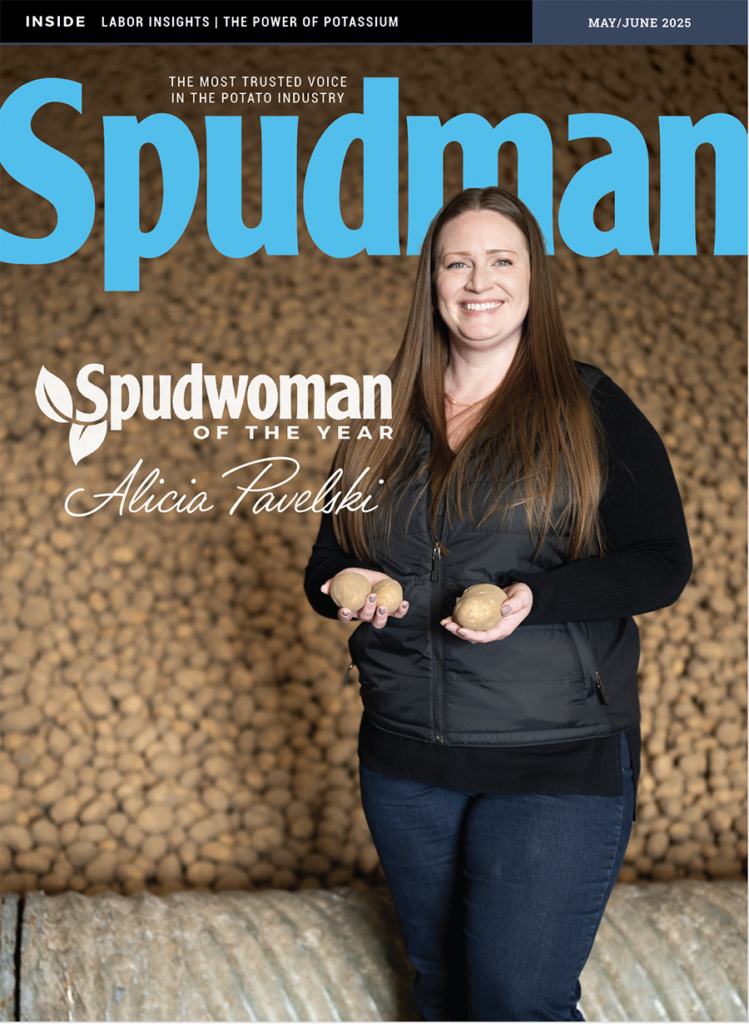Targeting exports
Seed potatoes represent just one percent of U.S. potato exports.
It’s a drop in the bucket. No matter. Some players in this tiny niche market are making a splash.
Nearly one-quarter of the 400 acres of seed potatoes Randy Bauscher grows in south-central Idaho are targeted for export.
Most of his foreign customers are small-scale farmers in Latin America who prefer yellow- and white-skinned spuds to the brown-skinned russets popular in the United States. He’s shipped seed to Panama, Uruguay, Nicaragua, Haiti, Sri Lanka and the Dominican Republic.
The rest of the world is not enamored with the Russet Burbank,” Bauscher said.
About 100 acres of his operation is planted to Granola, Cal White and other table-stock varieties earmarked for the export market.
Bauscher has visited nearly 20 countries in the past decade in an effort to develop new markets. Many of the trips have been sponsored by the United States Potato Board’s (USPB) seed export program.
Certified disease-free seed potatoes can be a huge benefit for farmers in developing countries who wrestle with heavy pest and disease pressures, Bauscher said.
Bauscher has set his sights on Africa and Brazil next. One of the largest potato growers in Egypt visited his farm near Rupert, Idaho, in July.
Bauscher’s ability to develop friendships with spud farmers around the world and his willingness to wade through piles of paperwork have made him one of the largest seed potato exporters in the U.S.
The red tape can be daunting.
“It took me about five years to get through all the protocol for Sri Lanka,” he said. His persistence has paid off with increased sales each year.
Exporters must adhere to a set of strict requirements that include securing import permits and phytosanitary certificates.
“The paper work is so arduous,” Bauscher said. “It’s not quick and it’s not easy.”
According to the USDA, seed exports during fiscal year 2012 (July 2011 to June 2012) amounted to 18,499 metric tons, or 1.2 percent of total U.S. potato exports.
However, U.S. seed potato export figures are not always reliable. Government trade data often fails to distinguish between seed and fresh potatoes.
“Sometimes seed is classified as fresh and fresh is classified as seed,” said John Toaspern, vice president of international marketing for the USPB.
Based on known sales to USPB’s target markets, Uruguay was the top destination for U.S. seed potatoes last year, with 975 metric tons. Nicaragua purchased 950 metric tons, followed by the Dominican Republic with 725 metric tons.
When the USPB first launched its seed export program some growers worried that it would become too successful and cut into U.S. imports of fresh and process potatoes.
In response, the board adopted a set of rules.
“We’ve tried to make is so that we are not in essence competing against ourselves,” Toaspern says. “For instance, it doesn’t make sense for us to promote processing seed varieties into markets where we are exporting frozen fries.”
Bauscher says the subsistence farmers who buy his seed potatoes pose no threat to the U.S. processing industry.
“Most of the countries that I’m working with are close to the Caribbean and they probably will never have french fry production,” Bauscher said. “Farming there is done with horses and oxen and by hand. They are never going to be a threat that way.”
The U.S. has a tiny share of the international seed market compared with major players such as Canada and the European Union.
The USPB has been trying to open new markets, in Brazil and Egypt.
Officially, the U.S. already has access to Brazil, but no shipments are taking place during an overhaul of Brazil’s seed potato laws.
U.S. seed producers have high hopes for Egypt.
Egyptian growers use modern irrigation practices to produce table-stock spuds for the export market.
“Since they need to import all of their seed potatoes, we feel there is a pretty good opportunity for U.S. seed to make some inroads into that market,” Toaspern said.
Toaspern toured Egypt’s potato production areas with other industry representatives earlier this year.
“There is an older growing region close to the Nile (River). It’s very fertile and the water is pretty close,” Toaspern said.
Farther from the Nile, Egyptian growers are trying to reclaim the desert for additional spud production.
“They’re dropping some really deep wells,” Toaspern said.
Gaining access to the Egyptian market would be huge for U.S. growers. Egypt is one of the biggest importers of seed potatoes in the world. During the 2010-11 marketing year, it imported 124,702 metric tons of seed potatoes from the European Union. Gaining a piece of that market could be just what U.S. potato growers need to become more than a bit player in the seed export game.














